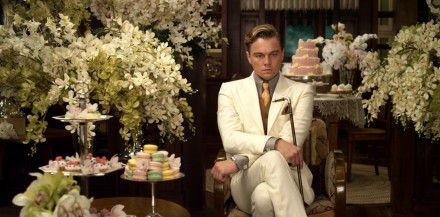Baz Luhrmann films are sort of like the Kardashian sisters of the movie industry. They’re pretty, loud, and unjustifiably rich. In a sense, “The Great Gatsby” movie adaptation feels almost as if a Kardashian herself had a perfectly manicured hand in the production of the film. Not like that’s a bad thing. As a stereotypical teenage girl, I positively enjoyed the film. But, as a literary connoisseur (qualified by all seven months I’ve spent in AP English Language) the movie seemed to miss the mark.
The bright colors and 3D effects were enough to send the average 70-year-old woman into epileptic shock. I understand that that’s sort of the point with Gatsby: the explicit flaunting of wealth and more gold than an English teacher can analyze for symbolism. However, the film seemed to take this a step too far. They appeared to miss the “social satire” in all the outrageousness that truly made “The Great Gatsby,” well, great.
In other words, Luhrmann took the book, bedazzled it, lit it on fire, and exploded it in the audience members’ faces. While it was entertaining, it was also a bit nauseating. It distracted from the actual plot, taking meaningful details from the book, like the green light and color gold, and exploiting them until the subtle magic of Fitzgerald was dulled by the exploding glitter confetti of Luhrmann.
It seemed to simplify the book into an inadequate, general message. The meaning behind the novel was sort of forced into a singular vision, leaving little leg room for the audience to stretch and interpret as they please.
However, I can’t really blame Luhrmann for most of this. First, “The Great Gatsby” is largely known for Fitzgerald’s incredible descriptions and linguistic style, enough to make the average English teacher fan girl with admiration. But, it’s obviously impossible to incorporate that completely into a visual piece, and as a result, part of the splendor of “The Great Gatsby” was compromised.
Second, even if Luhrmann’s interpretation was a bit aesthetically overwhelming, it’s still his interpretation. To go into the theatre expecting one’s own exact image of Gatsby to be projected on the screen is limiting and makes for a great deal of disappointment. In fact, that’s part of what makes books and movies satisfying. The creation and melding of new interpretations is what keeps books like “The Great Gatsby” alive. Even if his vision was different, it still kept Gatsby thriving with a 21st century dose of Luhrmann.
With a soundtrack incorporating modern millionaires like Kanye West and Jay Z, the movie seemed to parallel the wealthy feeling of the book. I mean, there are few richer in this world than Kim Kardashian and Beyonce’s baby daddies. Other jams like a jazz remix of Beyonce’s “Crazy in Love” and “Over the Love” by Florence + the Machine had me blasting the soundtrack all the way home.
The incredible cast added to the modern twist. Leonardo DiCaprio’s role as Jay Gatsby not only kept female viewers intrigued with his notoriously gorgeous face, but he also seemed to really become the character as he always does. From Luhrmann’s “Romeo and Juliet” to “The Great Gatsby,” DiCaprio has an incredible ability to add his own flare to a legendary character, while also respecting the original author’s vision. Jay Edgerton’s character as Tom Buchanan was also spot on. From the borderline Hitler mustache to that heir of elitism, Edgerton was a convincing Buchanan.
Like a Kardashian, “The Great Gatsby” film adaptation both irritated and entertained its audience. While it may not have satisfied every desire of AP Literature test graders everywhere, it brought a more modern edge to the almost century old book. Even if it wasn’t the equivalent of “The Great Gatsby,” it was at least a “Pretty Good Gatsby.”

